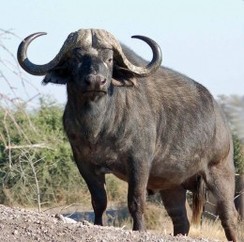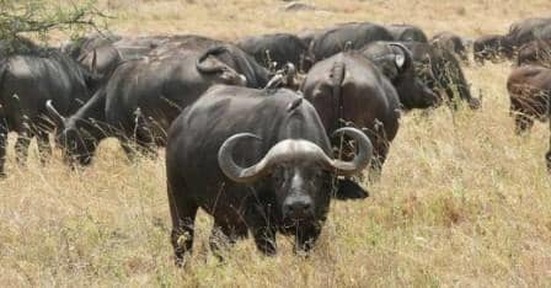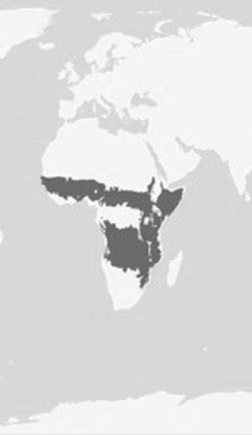Cape BuffaloSyncerus caffer |

Custom Search
|
|
The Cape Buffalo or African Buffalo (Syncerus caffer) is a herbivorous mammal that belongs to the Bovidae family. It is a member of the so-called "Big Five" group of african animals together with the elephant, rhino, lion and leopard.
It is a large animal that measures up to 3 m long and 1.7 m high and it's weight can reach more than 900 kg. Females are smaller than males. The Cape Buffalo lives in the sub-Saharan Africa, dwelling in savannas, forests and open and forested plains, but always near water. Their coat ranges in color from dark brown to black. They have large and thick horns, which fuse with each other in the middle of the forehead and are turned backwards. Cape Buffalos have very refined senses of smell and hearing, contrary to their vision which is very limited. They usually graze in the cool hours of the day or night and rest near water. They usually drink water in the morning or late in the day. The Cape Buffalo lives in herds of 50 to 500 individuals, in which there are well defined relationships.
They may gather in larger groups, with several thousand animals, in the Serengeti during the rainy season. The old males live alone or in small groups from 2 to 5 animals. There are few natural enemies to the Cape buffalo, among them we can mention the lions hunting in group and big crocodiles, and of course man. They have a lifespan of about 15 to 25 years.
They can be unpredictable and are very dangerous if cornered or wounded, making it one of Africa's most dangerous animals, killing several hundred people every year. The forest buffalo (Syncerus caffer nanus) is a smaller subspecies, it's found only in the forests of central and west Africa. Cape Buffalo - Diet They feed mainly on herbaceous plants. Cape Buffalo - Reproduction They mate in any season, but there are peaks related to the rainy season (so that births coincide with the the time of greater abundance of food). Gestation lasts about 340 days, after which is born a calf. Cape Buffalo females remain with their offspring, fiercely defending it from the herd to escape predators. They reach sexual maturity between three and a half and five years old. They usually have a calf only once every 2 years. Cape Buffalo - Conservation status and main threats
It is a species at risk and conservation dependent (International Union for Conservation of Nature). It has been threatened by habitat reduction (increase of cultivated land), diseases and mainly by hunting for sport and for food. Cape Buffalo is considered one of the most difficult animals to hunt on African safaris. Still, the population of these animals has been declining year by year. There are approximately 900000 Cape buffaloes in the wild.
|
Scientific classification
Kingdom: Animalia Phylum: Chordata Subphylum: Vertebrata Class: Mammalia Order: Artiodactyla Family: Bovidae Subfamily: Bovinae Genus: Syncerus Species: S. caffer |



